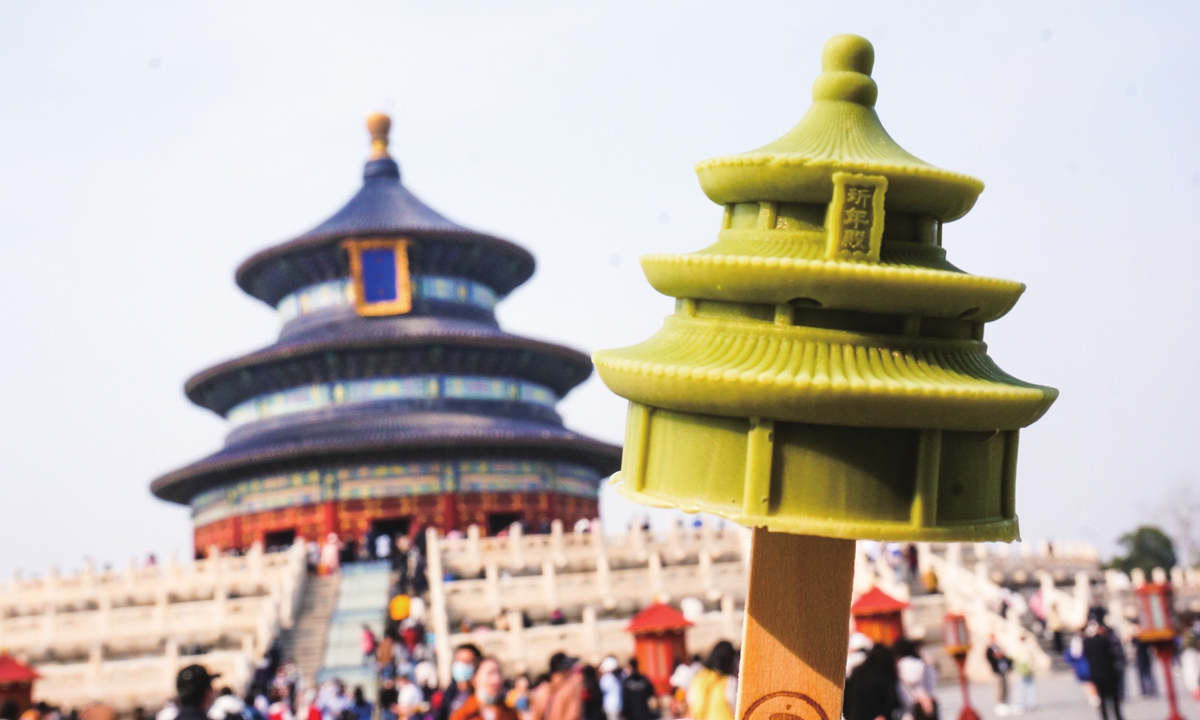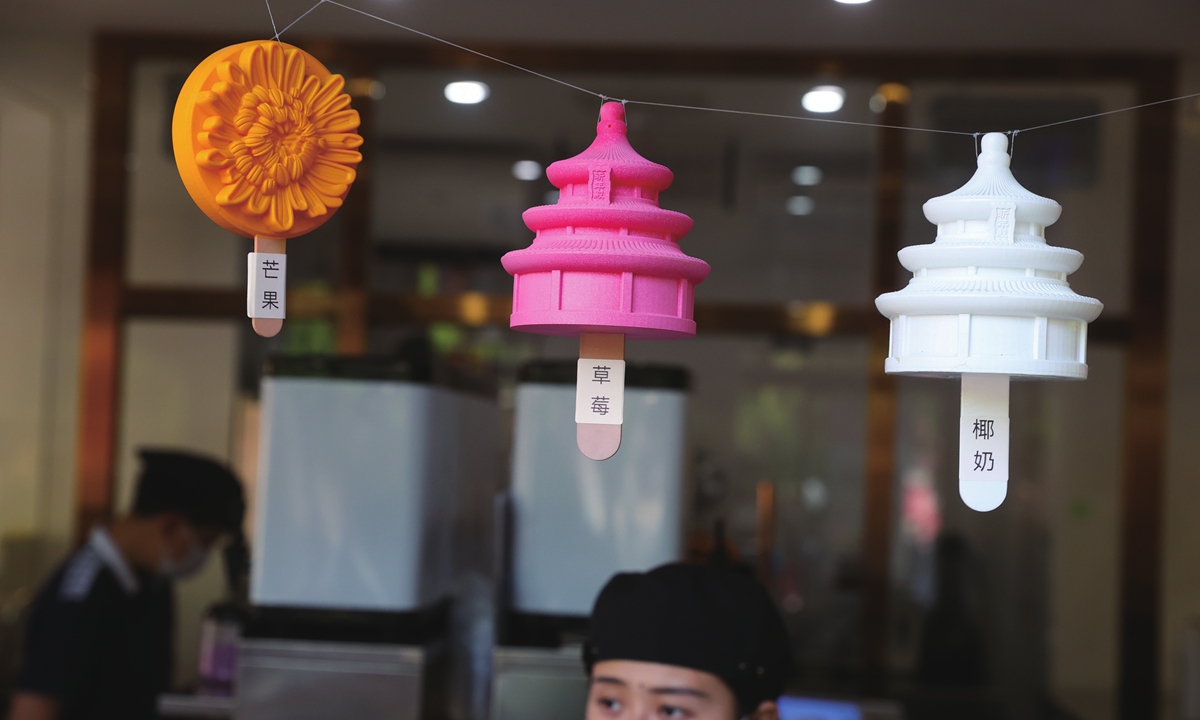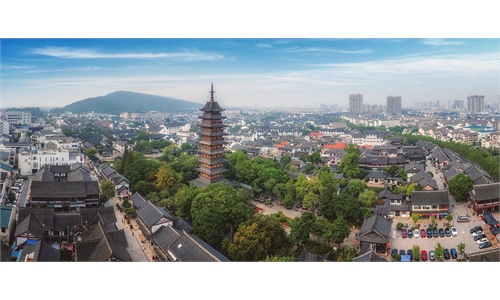ARTS / CULTURE & LEISURE
Return of 5-yuan ice cream era

Creative ice cream sold at Beijing's Temple of Heaven. Photos: VCG
As summer temperatures soar, there's nothing quite like indulging in a sweet frozen treat. Ice cream, the beloved "heat-beating magic wand" has entered its peak sales season.
In 2024, the ice cream market has seen a clear shift in consumer preferences, as the once-popular "ice cream assassins" (overpriced ice creams) have significantly diminished in presence. Instead, products priced below 5 yuan ($0.69) are now dominating the market.
Consumers are also placing higher demands on quality and value for money, with affordable, creative, and healthy ice creams emerging as a new growth driver.
Rational decisions
In June, "Ice Cream Returns to the 5-Yuan Era" became a trending topic on Weibo, Chinese X-like platform, sparking widespread discussions among netizens. As of Tuesday afternoon, the topic had garnered 63.8 million views and 16,000 comments.
In 2022, Moutai launched two flavors of ice cream: original Moutai and vanilla Moutai, priced at 39 yuan per serving, claiming that each ice cream contains Moutai liqueur. On social media in 2022, many people could be seen lining up to buy them, and they were often sold out.
However, despite the Moutai ice cream offering discounts this year, it has received little attention, according to media reports.
"Ice creams used to cost 0.5 yuan or 1-2 yuan each, and they tasted great. Nowadays, some have flashy packaging and high prices, so I don't really like eating them anymore," read a Weibo comment.
Another Weibo user echoed the view, saying "the 5-yuan ice cream is still a bit expensive. I really miss the old ice cream tastes of my youth. It's a pity that many shops don't sell them anymore."
According to the Xinhua News Agency, citing words from a 2023 survey, balancing price and value are crucial for the success of ice cream brands. Aa of 2023, 28,800 ice cream-related enterprises are based in China. While high-end ice cream brands have found success in previous years, some products with exorbitant prices but lacking in value have led to consumer skepticism and a push toward more rational purchasing decisions.
Retail analyst Yang Yu noted that the decline of high-priced ice creams, exemplified by brands, might signal a normalization and health-conscious trend in the ice cream market.
A popular online quip captures this sentiment well: "It's not that I can't afford international brands, but a 5-yuan ice cream offers better value for money." With rising consumer expectations for health, quality and taste, the demand for a balance between price, flavor, and health benefits has intensified.

Creative ice cream sold at Beijing's Temple of Heaven. Photos: VCG
Cultural elements
Riding the wave of creativity, cultural and nostalgic-themed ice creams, as well as collaborative brand ice creams, have been attracting enthusiastic buyers and spurring market growth.
Cultural and creative ice creams, in particular, have gained widespread popularity. Various tourist attractions, museums, and amusement parks across China offer uniquely themed ice creams. For instance, Beijing's iconic sites like the Palace Museum, the Summer Palace, Yuanmingyuan, the Temple of Heaven, and the Beihai Park have all introduced their own creative ice creams.
The Palace Museum's "roof animal" ice cream, initially launched in 2019, received high praise, as did the Sanxingdui Museum's bronze mask ice cream and the panda-themed ice creams at the Chengdu Research Base of Giant Panda Breeding.
These creative ice creams not only offer visitors a treat during their traveling, but also embody cultural elements related to the visiting spots.
Liu, a 28-year-old visitor, shared her experience of purchasing a 15-yuan ice cream from the Palace Museum. "The taste wasn't particularly special, but its unique shape was very appealing and photogenic, and the price wasn't too high."
Classic nostalgic ice creams have also gained traction on social media. These time-honored treats, having withstood market competition, remain popular due to their affordability and familiar flavors.
A local retailer in Beijing's Chaoyang District told the Global Times that ice creams priced below 5 yuan, such as the traditional Laobinggun, Nuomici, and Xiaobuding, sell especially well because of their reasonable prices and good taste.
A customer in Beijing's Chaoyang District told the Global Times, "My family will purchase many Laobinggun ice creams every summer. They think it's not excessively sweet and it's also cheap."
Selective consumption
Consumers now prefer reasonably priced, delicious, and high-quality ice creams. Health trends have further influenced buying habits, with clear ingredient lists and reduced sugar or fat content becoming key factors in purchasing decisions.
Additionally, the trend toward healthier options, like low-sugar ice creams, has made it easier for fitness enthusiasts to enjoy these treats and mini-sized portions are also becoming popular, offering a satisfying yet guilt-free indulgence that can be shared.
On the lifestyle-sharing platform Xiaohongshu, many users share sugar-free or low-sugar ice cream brands, with some users even sharing tutorials about making them.
In addition to chocolate and dairy flavors, fruit-flavored ice creams remain a staple, with brands emphasizing the use of real fruit juice, chunks, and purees. Popular flavors include strawberry, coconut, peach, red bayberry, mango, grape, and blueberry.
Notably, while consumers seek value for money, they also prioritize the overall consumption experience and personal satisfaction, and the new generation's penchant for refined and selective consumption is becoming a trendsetter in the food market.
Indeed, beyond basic information like price and shelf life, consumers are increasingly scrutinizing ingredients and nutritional content, reflecting a growing awareness of rational and healthy consumption.



